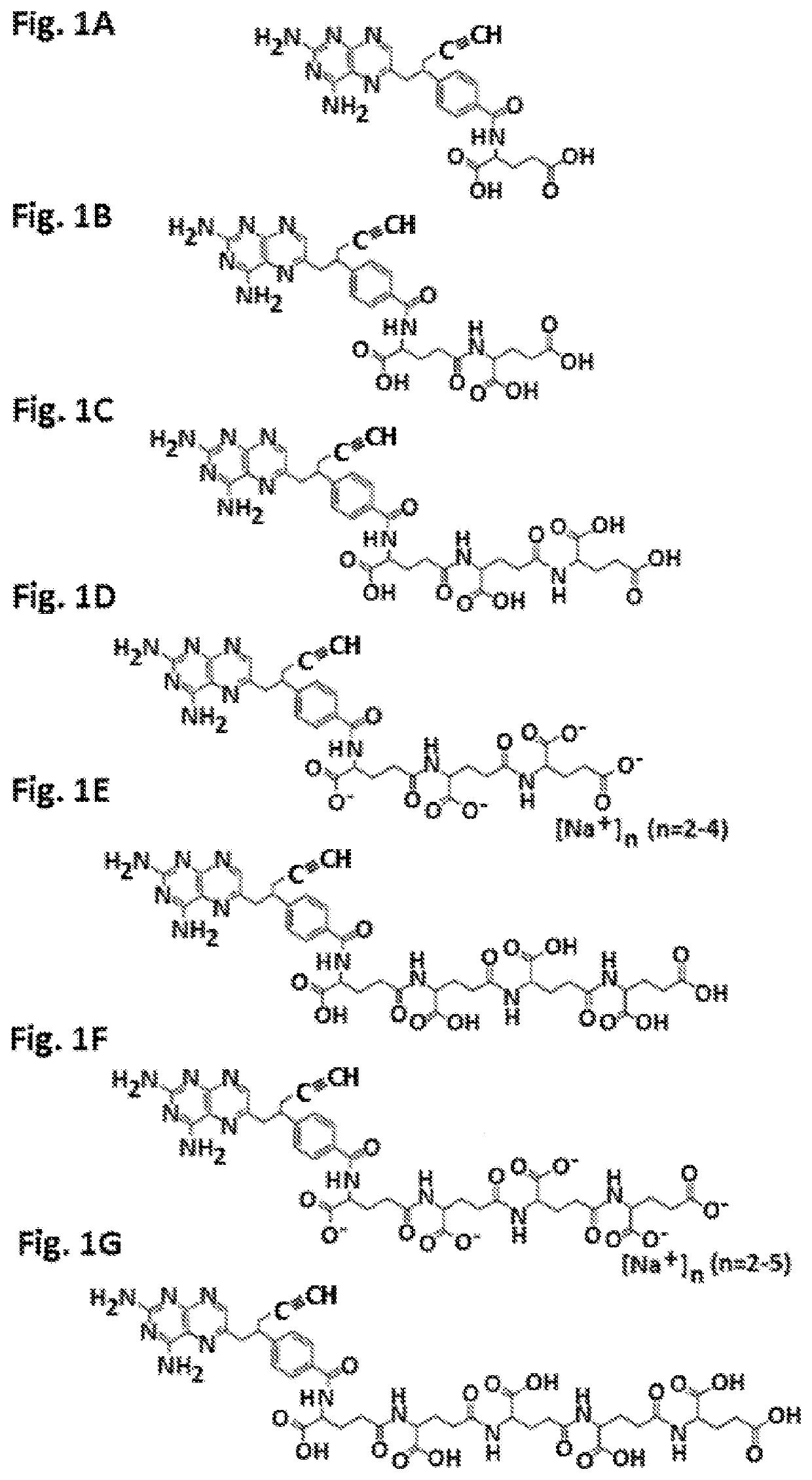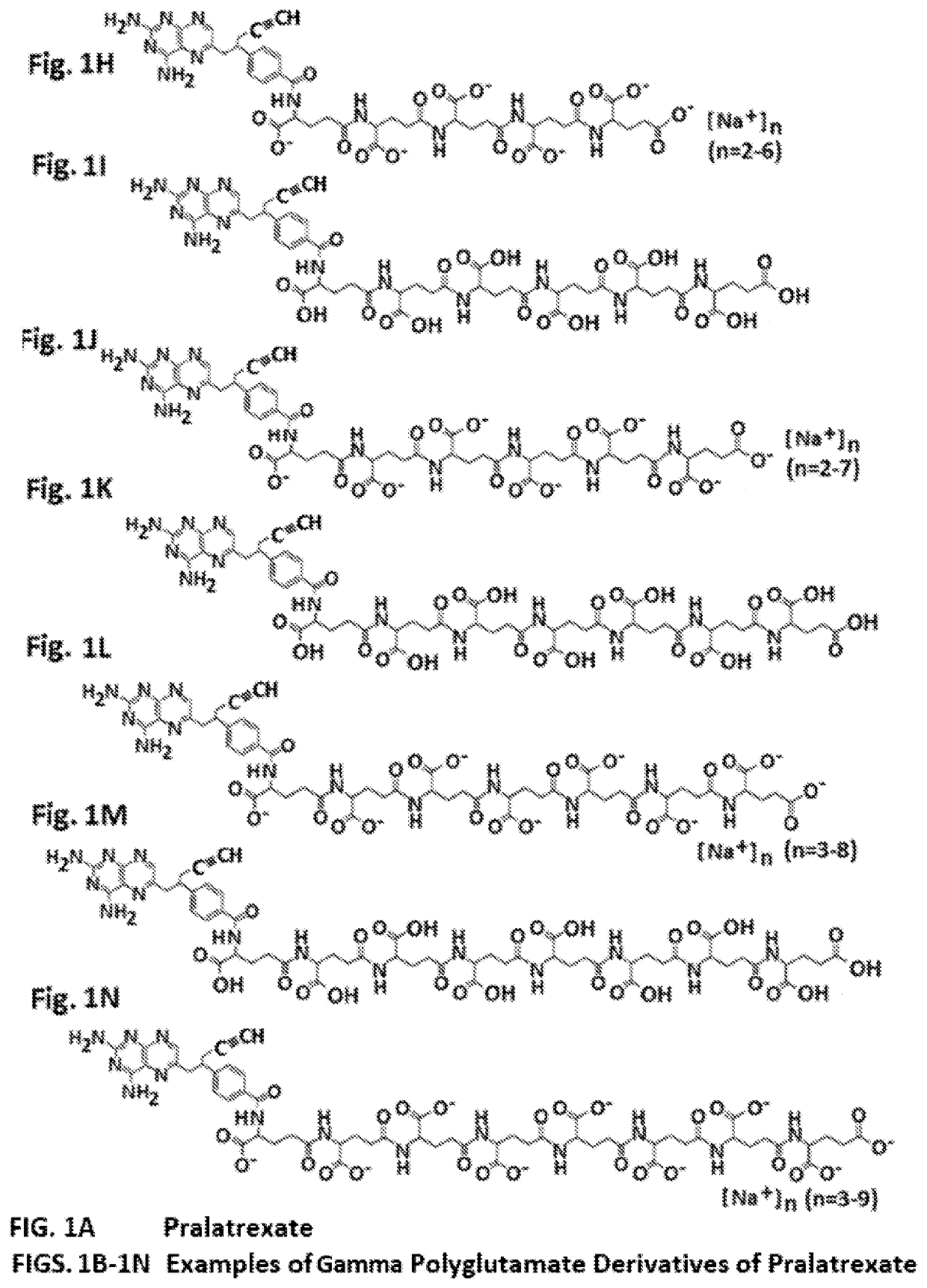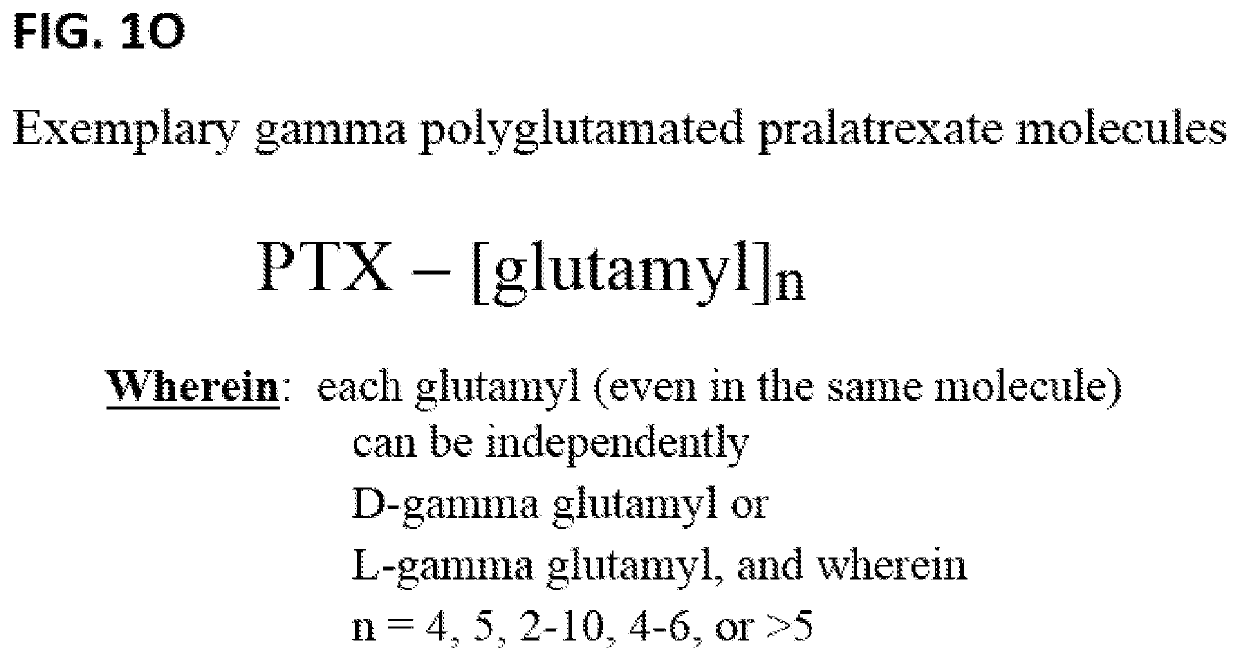Gamma polyglutamated pralatrexate and uses thereof
a technology of pralatrexate and polyglutamated pralatrexate, which is applied in the direction of drug compositions, immunoglobulins, peptides, etc., can solve the problems of pralatrexate treatment suffering from dose-limiting toxicity, pralatrexate treatment often suffers from dose-limiting toxicity, and the effect of low toxic side effects
- Summary
- Abstract
- Description
- Claims
- Application Information
AI Technical Summary
Benefits of technology
Problems solved by technology
Method used
Image
Examples
example 1
Gamma Polyglutamated Pemetrexed Compositions
[0612]Methods:
[0613]Production of Gamma Hexaglutamated Pemetrexed (γHGPMX) Liposomes
[0614]Briefly Gamma HGP (gG6) was encapsulated in liposomes by the following procedure. First, the lipid components of the liposome membrane were weighed out and combined as a concentrated solution in ethanol at a temperature of around 65° C. In this example, the lipids used were hydrogenated soy phosphatidylcholine, cholesterol, and DSPE-PEG-2000 (1,2-distearoyl-sn-glycero-3-phosphoethanolamine-N-[methoxy (polyethylene glycol)-2000]). The molar ratio of HSPC: Cholesterol: PEG-DSPE was approximately 3:2:0.15. Next, the gG6 or gDG6 was dissolved in 5% dextrose at a concentration of 100-150 mg / ml with a pH of 6.5-6.9. The drug solution was heated up to 65° C. The ethanolic lipid solution was injected into the gG6 or gDG6 solution using a small-bore needle. During this step the drug solution was well stirred using a magnetic stirrer. The mixing was performed a...
example 2
Liposome Polyglutamated Pemetrexed Cell Delivery
Methods
Production of Targeted Gamma Hexaglutamated Pemetrexed (HGP) Liposomes
[0627]Gamma HGP (gG6) was encapsulated in liposomes and the liposomes were downsized and purified according to procedures essentially as set forth above in Example 1.
Antibody Conjugation
[0628]Activated liposomes were prepared by adding DSPE-PEG-maleimide to the lipid composition. The liposomes contain four different lipids: hydrogenated soy phosphatidylcholine (HSPC), cholesterol, 1,2-distearoyl-sn-glycero-3-phosphoethanolamine-N-[methoxy(polyethylene glycol)-2000](DSPE-PEG-2000), and 1,2-distearoyl-sn-glycero-3-phosphoethanolamine-N-[maleimide (polyethylene glycol)-2000] (DSPE-PEG-maleimide), in ratios of 3:2:0.1125:0.0375.
[0629]Antibody thiolation was accomplished through use of Traut's reagent (2-iminothiolane) to attach a sulfhydryl group onto primary amines Antibody was suspended in PBS at a concentration of 0.9-1.6 mg / ml. Traut's reagent (14 mM) was adde...
example 3
tudies
[0643]The following example describes in vivo efficacy and toxicity data obtained upon administering alpha G6 (Lp-aG6) (alpha polyglutamated pemetrexed) in an in-vivo (murine) model. Those skilled in the art will appreciate that the efficacy and reduced toxicity observed for liposomal alpha polyglutamated pemetrexed compositions is expected to also be observed upon administration of the counterpart liposomal gamma polyglutamated pemetrexed (gamma G6 (Lp-gG6) under the same conditions, albeit at possibly different levels.
Methods
Safety Studies in Mice
[0644]Because some of the major toxicities associated with a pemetrexed based treatment are hematologic and hepatic, it is important to evaluate the effect of Liposomal alpha G6 (Lp-aG6) in an in-vivo (murine) model and compare the changes in hematologic and the liver serum chemistry panel following treatment. To obtain this data an initial dose ranging study was conducted using healthy female BALB / c mice (6-8 weeks old) which were ...
PUM
| Property | Measurement | Unit |
|---|---|---|
| diameter | aaaaa | aaaaa |
| diameter | aaaaa | aaaaa |
| diameter | aaaaa | aaaaa |
Abstract
Description
Claims
Application Information
 Login to View More
Login to View More - R&D
- Intellectual Property
- Life Sciences
- Materials
- Tech Scout
- Unparalleled Data Quality
- Higher Quality Content
- 60% Fewer Hallucinations
Browse by: Latest US Patents, China's latest patents, Technical Efficacy Thesaurus, Application Domain, Technology Topic, Popular Technical Reports.
© 2025 PatSnap. All rights reserved.Legal|Privacy policy|Modern Slavery Act Transparency Statement|Sitemap|About US| Contact US: help@patsnap.com



